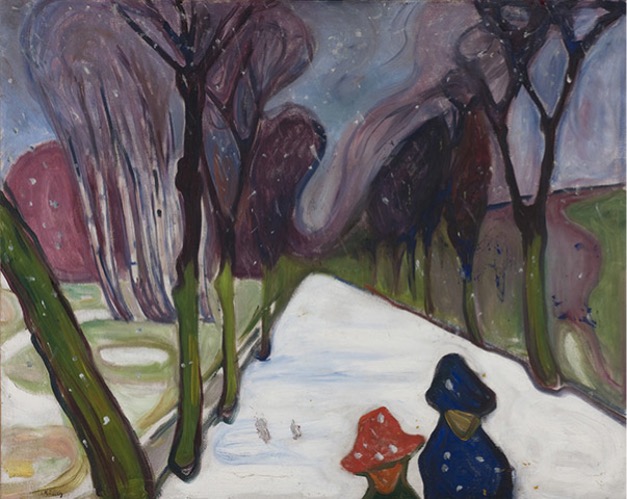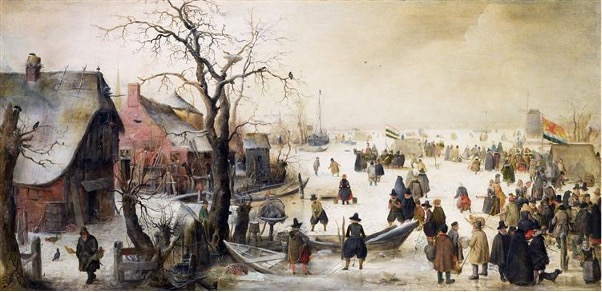
Here in the UK, we rarely experience the amount and duration of snowfall depicted by the Impressionist painters of the late nineteenth century, such as Camille Pissarro, Alfred Sisley and Claude Monet. They were entranced by the transformational effects of light and shadow falling on snow. Sisley (above) shows us a familiar slushy village street indicating unseen activity, while Monet’s famous Magpie painting, captures the deep blue/purple shadows on fresh snow cast by a low, winter sun. This 2 minute video illustrates the wonderful variety of Monet’s winter landscapes.

Pissarro gives us the delicate white filigree of a line of tall, frosty trees. This idea of patterns in snow is taken up by contemporary sculptor Andy Goldsworthy in his work ‘Snowball Tree’, where doughnut shaped snowballs create a fretwork screen between divergent branches.


American Impressionist, Childe Hassam, tackles the effects of snow in the city by showing commuters trudging over a blanketed Brooklyn Bridge in New York. The girl in the pastel drawing, ‘Child in Green Coat’, by Hassam’s contemporary, Mary Cassatt, is certainly dressed for winter.


Bloomsbury Group artist Vanessa Bell was inspired by the season to paint her winter scene of her Sussex farmhouse under snow at Charleston, Sussex.

Atkinson Grimshaw created a very different winter study. His painting ‘A Moonlit Winter’s Evening’ has been painted in green. Here a suburban Victorian street scene takes on an eerie, atmospheric and almost supernatural form. In a similar vein, expressionist Edvard Munch turns a snow-filled, tree-lined avenue into a swirling, hallucinatory cavern.


British 18th century watercolourist John Robert Cozens conveys the insignificance of humans, when set against the scale and grandeur of the snow-covered French Alps. Constable considered him the finest landscape painter of his time. In his dramatic ice-scape ‘The Wreck of the Hope’, German nineteenth century romantic painter Caspar David Friedrich makes it very clear where the balance of power lies between human exploration and the forces of nature.


Human activities feature in many well-known portrayals of winter, right back to the 1500’s when Pieter Bruegel the Elder painted his Hunters in the Snow. He cleverly uses the whiteness of the landscape to highlight the dark figures, animals and the distant village at the foot of his trademark vertiginous cliff. This short video gives a more in-depth analysis of this painting.

The two ptarmigan in Victorian society-painter Edwin Landseer’s work illustrate the ruthless side of natural survival in a harsh environment.

In Hendrick Avercamp’s Winter Scene on a Canal, the whole town seems to have decamped onto the frozen waterway to hold a fair. By contrast, Henry Raeburn focuses on the poise and elegance of a lone ice-skater. A hundred years earlier in Japan, Kitagawa Utamaro studied a Geisha Walking Through Snow at Night.



Early twentieth century Russian neo-primitivist painter Natalia Goncharova depicts peasants gathering wood for simple warmth and survival just as Vincent van Gogh had shown peasant women having to dig in a snow-covered field, possibly for vegetables.


Barbara Hepworth, best known for her abstract curved sculptures, also made prints as evidenced by the work below, ‘Winter Solstice’. This nevertheless still contains her trademark interest in ancient forms, natural and manufactured, whose apertures suggest the inner lives of things.

In this video of a recent immersive work, ‘Snow’, by Japanese artist Tokujin Yoshioka, white feathers stand in for snowflakes very effectively.
Finally, concern for the environmental crises that face us informs recent works by Olafur Eliasson and Minik Rosing. To make the work ‘Ice Watch’, ice blocks from ice floes were shipped down to London’s South Bank from Greenland to highlight the rapid melting of our glaciers. This short but powerfully moving time-lapse video shows Eliasson’s ice blocks arriving in London and then melting back into the river/sea. Finally, Tacita Dean shows us the stark beauty of our disappearing ancient trees in winter.
